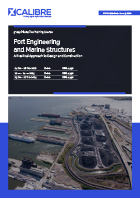| Date | Venue | Fee | |
|---|---|---|---|
| 06 Jul - 10 Jul 2026 | Dubai – UAE | $ 5,950 | Register Now |
| 19 Oct - 23 Oct 2026 | Dubai – UAE | $ 5,950 | Register Now |
About the Course
Port and Harbor Engineering is a branch of civil engineering concerned with the design, construction, and operation of ports, harbours, canals, and other maritime facilities. Port engineering and marine structures are one of the most important engineering branches. Engineers from almost all disciplines work together to design and construct all port facilities.
The Port Engineering and Marine Structures training course introduces the natural phenomenon affecting ports and marine structures in coastal zones and explains the motion of wave mechanics and wave transformation. It introduces the main aspects affecting the port elements design, such as Bathymetric Survey, Geotechnical Investigation and MetOcean Data. The delegates will understand how to develop the port master & dredging plans; and will learn how to design and construct different types of quay walls and some unique aspects of marine structures design and construction such as scour around marine structures, soil liquefaction, and pile driving under challenging soils; and the impact of climate changes and sea level rise on marine structures.
Furthermore, the key concepts and basic knowledge of Port and Harbor Engineering and marine structures will enable the delegates to understand the essentials of the design and construction of port elements. Likewise, it highlights the effect of global warming and sea level rise on ports and coastal areas.
Core Objectives
The delegates will achieve the following objectives:
- Understand how to design mooring and berthing facilities
- Understand the natural phenomenon affecting the design of the port
- Know wave properties essential to the design of ports and marine structures
- Acquire the basics of ports master planning
- Understand how to design and construct different port elements
- Learn about the design and construction of breakwaters and berthing facilities
- Appreciate the design of jetties
- Understand how to design mooring and berthing facilities
Training Approach
This training course will combine presentations with instructor-guided interactive discussions between delegates relating to their interests. Practical exercises, video material and case studies aiming at stimulating these discussions and providing maximum benefit to the participants will support the formal presentation sessions. Above all, extensive use of case examples and case studies of issues has been personally involved.
The Attendees
Ports serve as essential transportation hubs facilitating passengers and goods movement; hence, this will benefit all professionals directly or indirectly with the design and construction of ports, harbours and marine structures.
This training course will be valuable to professionals, including (but not limited to) the following:
- Construction and Civil Engineers
- Port Operators
- Pilots
- Project Engineers
- Offshore Structure Engineers
- Managers and Executives who are new to the port engineering industry
- Port and Coastal Engineers who want to expand their knowledge in port engineering and marine structures
- Structure Engineers involved in the design or construction of ports and marine structures
Daily Discussion
DAY ONE: OVERVIEW OF PORT ENGINEERING AND OFFSHORE STRUCTURES
- Types of Ports
- Typical Beach Profile
- Introduction to Offshore Structures
- The Marine Environment
- Wind: Wind Rose
- Water Waves
- Tides, Currents, and Water Levels
- Wave Theories
DAY TWO: BATHYMETRIC SURVEY, GEOTECHNICAL INVESTIGATION AND WAVE MECHANICS
- Subsea Surveying, Positioning, and Foundation
- Offshore Site Investigations
- Wave Refraction
- Wave Diffraction
- Wave Breaking
- Simplified Methods for Estimating Wave Conditions
- Wave Impact and Wave Forces on Walls
DAY THREE: PORT MASTER PLANNING AND NAVIGATION CHANNELS
- Port Master Planning
- Design of Navigation Channels
- Navigation Aids
- Dredging Level
- Types of Breakwaters
- Design and Construction of Rubble Mound Breakwaters
- Design of Combined Breakwaters
DAY FOUR: BERTHING FACILITIES
- Types of Berthing Facilities: Quay Walls and Piers
- Design of Lock Block Quay Wall
- Design of Axially Loaded Piles
- Design of Laterally Loaded Piles
- Pile Group Effect
- Mooring Analysis: Bollards Design
- Berthing Forces and Fender Design
- Wave Forces on Jetty Deck & Piles
DAY FIVE: MARINE STRUCTURES DESIGN & CONSTRUCTION - SCOUR, SOIL LIQUEFACTION, PILE DRIVING, SLIPWAY DESIGN, AND SEA LEVEL RISE
- Effect of Scour on Piles Supporting Marine Structures
- Effect of Liquefaction on Dock Structures
- Cathodic Protection Design
- Slipways
- Deepening of Existing Quay Walls
- Impact of Climate Change and Sea Level Rise on Coastal Structures
Certificate Awarded
Upon successful completion of this training course, participants will be awarded a Certificate of Completion from XCalibre Training Centre, acknowledging their accomplishment. This certificate serves as a testament to their dedication to developing their skills and advancing their expertise in their respective fields.



